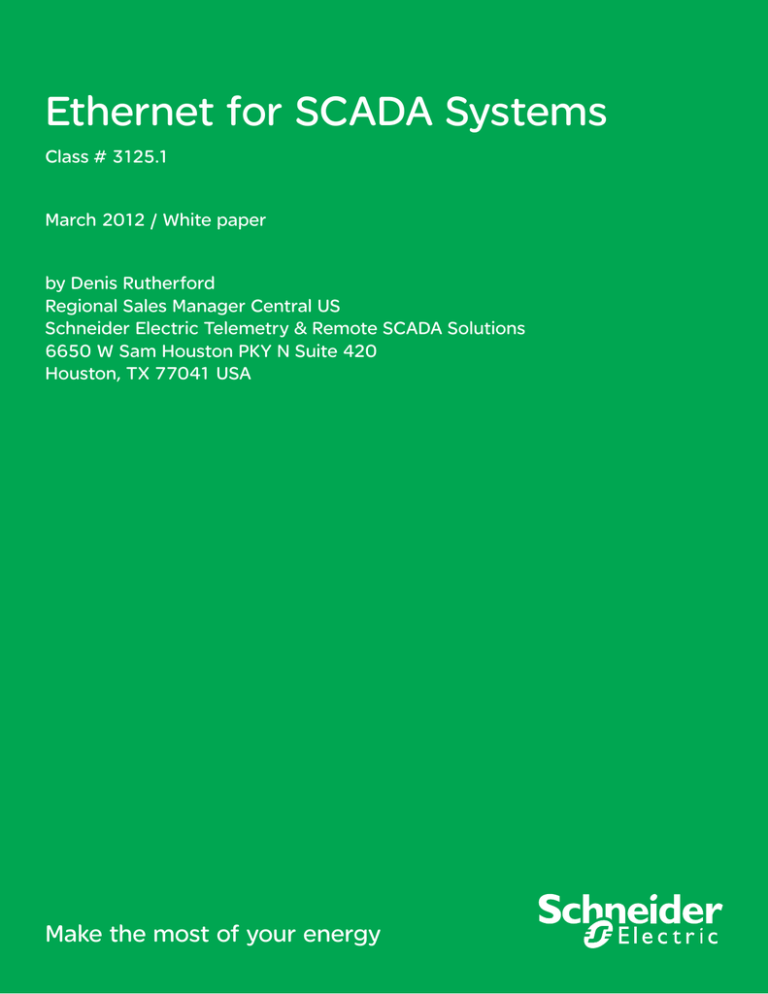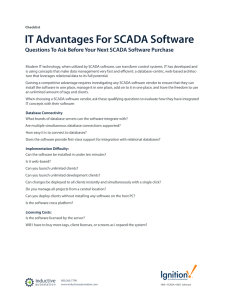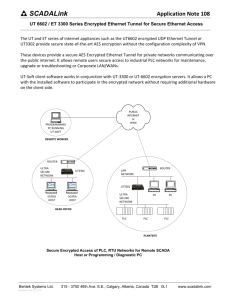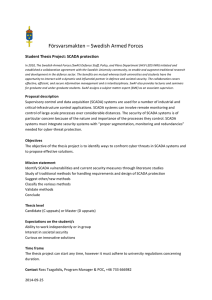
Ethernet for SCADA Systems
Class # 3125.1
March 2012 / White paper
by Denis Rutherford
Regional Sales Manager Central US
Schneider Electric Telemetry & Remote SCADA Solutions
6650 W Sam Houston PKY N Suite 420
Houston, TX 77041 USA
Make the most of your energy
Summary
Executive Summary ......................................................................................... p 2
Introduction ..................................................................................................... p 3
The Evolution of SCADA Systems .................................................................... p 4
SCADA Trends ................................................................................................. p 6
Common System Components ........................................................................ p 7
Ethernet Value to Users ................................................................................... p 9
Conclusion ...................................................................................................... p10
Ethernet for SCADA Systems
Executive summary
This paper will cover the implementation of Ethernet applications in SCADA
system communications and architecture.
White paper on Ethernet for SCADA Systems | 02
Ethernet for SCADA Systems
Introduction
Supervisory Control and Data Acquisition (SCADA) systems provide a superior
base for better-controlled facilities in the upstream, midstream and pipeline
markets for Oil and Gas. Computerised handling of remote installations is
integrated with communications and provides a means for reducing operating
and maintenance costs and providing effective handling of the oil and gas
network. System parameters communicated via wireless data network must
present true conditions related to the status of the field equipment including
Custody Transfer Measurement Systems. In a similar manner, commands sent
to remote sites must be promptly executed and their feedback indication sent to
the control center.
White paper on Ethernet for SCADA Systems | 03
Ethernet for SCADA Systems
The Evolution of SCADA Systems
SCADA systems have evolved through three
generations of architectures as follows:
Monolithic
In its first generation, SCADA was performed by
mainframe computers. Networks did not exist at
the time. Thus SCADA systems were independent
systems with no connectivity to other systems such
as Gas Measurement Systems connected to Control
Systems. Common Wide Area Networks (WANs)
were later designed by Remote Terminal Unit (RTU)
vendors to enable communication between the RTU
and Flow Computer. The communication protocols
were proprietary at that time. In these types of
systems it was necessary to have two different
networks to the individual collection systems.
This meant multiple controllers and different
Networked
Networked systems are the current generation of
SCADA and EFM Measurement Systems, using
open architecture rather than a vendor-controlled
proprietary environment. The SCADA system
utilises open standards and protocols, thus
distributing functionality across a WAN rather than
a LAN. It is easier to connect third-party peripheral
systems such as Wireless Communication
Infrastructure-Monitoring Systems and Network
Monitoring Systems (SNMP), due to the use of
open architecture. WAN protocols such as Internet
Protocols (IP) are used for communications between
the master station and communications equipment.
Ethernet Protocols
communication systems to communicate to their
There are two types of IP traffic: Transmission
respective host systems.
Control Protocol (TCP) and User Datagram Protocol
Distributed
In its second generation, the process was
distributed across multiple stations that were
connected through a Local Area Network (LAN),
sharing information in real time. Each station was
responsible for a particular task thus making the
size and cost of each station less than one used
in a Monolithic system. Network protocols were
still mostly proprietary. These types of systems
continued to require multiple RTUs and EFMs on
site, but utilised one host system to communicate to
each controller.
(UDP). Of the two, TCP is the most commonly used
protocol on SCADA Systems. The reason for this
is TCP offers error correction. Where TCP protocol
is used there is “guaranteed delivery.” This is due
largely in part to a method called “flow control” that
determines when data needs to be re-sent, and
stops the flow of data until previous packets are
successfully transferred. If a data packet is sent, a
collision or an error in the wireless communications
may occur. When this does, the RTU/Client rerequests the packet from the Host/server until the
whole packet is complete and is identical to its
original.
White paper on Ethernet for SCADA Systems | 04
Ethernet for SCADA Systems
UDP is another commonly used protocol on the
There are some radio and host systems that can
Internet. However, UDP should not be used to
handle a dropped data packet at the Application
send important data such as Custody Transfer
Layer, a unique set of instructions that sends
Measurement Data, database information, etc;
confirmation messages back to the Host once
UDP is best-suited for streaming audio and video.
the data is received. This is advantageous when
Streaming media such as JPEGS, Windows Media
transmitting data over communications systems that
audio files (.WMA) , Real Player (.RM), and others
charge by the byte such as cellular modems.
use UDP because it offers desired transmission
speeds. UDP is faster than TCP because there is
no form of flow control or error correction. However,
data sent over the Internet will be affected by
collisions, and errors will occur. Remember that UDP
is only concerned with speed, not quality. This is
mostly why streaming media is not high quality.
TCP vs UDP
Attributes
TCP
UDP
Acronym For
Transmission Control Protocol
User Datagram Protocol or Universal Datagram
Protocol
Packet ordering
TCP rearranges data packets in the order specified.
UDP does not order packets. If ordering is
required, it has to be managed by the application
layer.
Error-checking
Yes
No
Header size
20 bytes
8 bytes
Usage
Non time-critical applications
Fast transmission of data: This is great for
Streaming video or pushing JPEGs
Function
As a message makes its way across the Internet from
one computer to another. This is connection based.
UDP is also a protocol used in message transport
or transfer. This is not connection based which
means that one program can send a load of
packets to another and that would be the end of
the relationship.
‘Weight’
Three packets required to set up a socket connection
before any user data can be sent. TCP handles
reliability and congestion control.
Lightweight. There is no ordering of messages, no
tracking connections, etc. It is a small transport
layer designed on top of IP.
Streaming of Data
Data is read as a byte stream, no distinguishing
indications are transmitted to signal message
(segment) boundaries.
Packets are sent individually and are checked for
integrity only if they arrive. Packets have definite
boundaries which are honored upon receipt,
meaning a read operation at the receiver socket
will yield an entire message as it was originally
sent.
Speed of Transfer
TCP is slower than UDP
UDP is faster because there is no error-checking
for packets.
Data Reliability
There is an absolute guarantee that the data
transferred remains intact and arrives in the same
order in which it was sent.
There is no guarantee that the messages or
packets sent will reach at all.
White paper on Ethernet for SCADA Systems | 05
Ethernet for SCADA Systems
SCADA Trends
The trend for HMI/SCADA software and PLC is
determinism, certain issues in the adoption of
‘mix and match’. Many exploration and production
Ethernet in some specialised applications have been
companies acquire production fields from other
created. Ethernet networks have been accepted by
companies. These new acquisitions often come
the Oil & Gas market for HMI SCADA.
with other manufacturer’s instrumentation. The
end users whose investments were restricted
With the integration of Ethernet into SCADA, the
to only one vendor’s hardware solution found
ability to remotely control, monitor, and troubleshoot
problems. By the late 1990s, instead of using
network devices has increased. This increase
serial RS-485, the shift to open communications
in visibility and availability has led many energy
continued, including the SCADA Remote Telemetry
companies with vast geographical areas, such as
Manufacturers (RTUs), who used open message
Production, Pipeline and Distribution, to question
structures like Modbus ASCII and Modbus RTU
the ideas of traditional LAN networks and to test
(both developed by Modicon). By 2000, almost
new distance requirements and features.
all the RTU makers offered fully open interfacing
such as Modbus TCP. Traditionally, SCADA and
Measurement Instrumentation were two different
pieces of equipment. As technology improved,
many companies combined their EFMs and SCADA
Instrumentation into one controller. This reduced
the cost of the overall system. With open Ethernet
communication protocols like Modbus TCP, Modbus
UDP, and DNP3 WAN/LAN, it became much simpler
to integrate data through a networked SCADA
Communications System. Mixing and matching
of products from different vendors for developing
better solutions became possible because of the
use of open architecture SCADA systems and hence
were better than the solutions developed when the
choices were restricted to one vendor’s products.
SCADA systems are now in line with the standard
networking technologies. The old proprietary
standards are being replaced by TCP/IP protocols.
However, due to certain frame-based, network
technology characteristics like synchronisation,
environment suitability, protocol selection and
For example, a modern energy company might have
Dry Natural Gas production facilities in the Barnett
Shale, Wet Gas production facilities in the Eagle
Ford Shale and processing facilities in Oklahoma,
and want them all to be interconnected. Ethernet
technology allows for companies to interlink these
diverse and yet equally business-critical networks
together while preserving communication integrity,
simplifying control and minimising the staff needed
to operate these facilities.
Ethernet offers the SCADA designer scalability.
There is no theoretical limit to the number of
stations in a network. The data transfer rate of a
serial communications system such as RS232, is
about 19.2k. 100Base-T Ethernet provides 5000x
that of RS232. When looking at cabling distance
(without repetition) for RS232, the limit it is 23m
(~75ft). Ethernet over low-voltage, CAT3 cable is
91m (~300ft). Wireless Ethernet can span 96Kms
(60mi) or more via link bridge repeaters. Industrial
Ethernet products can offer continuous operating
temperature ranges from -40 to +75°C (-40 to
+167°F), environmental conditions for shake
and vibration, and can be installed in hazardous
environments that meet Class I Div 2 ratings in oil
and gas facilities.
White paper on Ethernet for SCADA Systems | 06
Ethernet for SCADA Systems
Common System Components
In order to understand how Ethernet
The flow data is made available externally
Communications work in oil & gas applications, a
through an electronic interface allowing other
look at the different components that make up an
computers to download the information for
Ethernet SCADA System is required.
the purposes of supervision, accounting or
auditing. Many types of flow meter equipment
A SCADA system typically consists of the following
implement flow computers intrinsically. There are
subsystems:
dedicated flow meters and various RTUs that
• A supervisory (computer) system, gathering
(acquiring) data on the process and sending
commands (control) to the process.
• RTUs connecting to sensors in the process,
converting sensor signals to digital data and
sending digital data to the supervisory system.
RTUs have multiple communications ports:
RS232/485, USB and Ethernet.
• Programmable Logic Controllers (PLCs) used as
field devices because they are more economical,
versatile, flexible, and configurable than specialpurpose RTUs. PLCs are used to alarm monitor
and control a process.
• Electronic Flow Meters (EFM/Flow Computer)
is an electronic computational device which
implements the required algorithms to turn the
can be used as flow computers, most notably
from Schneider Electric, Eagle Research Corp.,
Fisher/Rosemount, Totalflow, Bristol-Babcock,
Emerson, and Omni.
• Ethernet radios bring wireless Ethernet
connectivity to the field. These radios transmit
over the 900MHz and 2.4GHz license-free
frequencies. Data throughput on a pair of radios
range from 256K to 512K baud. Recently,
technology has been developed in the 400MHz
licensed frequencies to support longer range
communications. However, data throughput is
reduced at these lower frequencies. Some of
the more advanced radios come with multiple
Ethernet and serial ports. This enables a serial
device to connect easily to a network system.
Packet-routing is based on the IP address & port
number that’s used.
raw data received from flow meters (to which it is
connected) into flow volumes at base conditions.
White paper on Ethernet for SCADA Systems | 07
Ethernet for SCADA Systems
Ethernet Radio Communication for Multiple Applications
Sites with Primary
Application Only
SCADA
Host
Site with Primary and
Secondary Applications
Secondary
Application
Site with Secondary
Application Only
• Device Servers are gateway devices that
• Cellular Modems are wireless Ethernet
connect serial communication ports to a
modems that work over the cellular phone
network connection. These devices can be
infrastructure. When the remote communication
powered by 12V solar-powered systems. A
infrastructure is not large enough to install a
Device Server is a great way to connect legacy
radio communications system, cellular modems
serial data systems to the network.
are used.
• Ethernet switches connect communication
• Human Machine Interface (HMI) is the apparatus
processors and other devices to the wide area
which presents process data to a human
network. Ethernet switches allow any Ethernet-
operator, and through which the operator
capable device to be connected to the network.
controls the process. A typical HMI used in the
This device is a natural choice for SCADA
SCADA system is a display. With Ethernet as
Systems that require Ethernet communications.
a standard option on many models, you can
In replacing Ethernet hubs in existing networks,
network-enable any serial devices connected to
this unit reduces the amount of wiring by
the display.
concentrating Ethernet lines, and provides
increased bandwidth performance by eliminating
message collisions.
White paper on Ethernet for SCADA Systems | 08
Ethernet for SCADA Systems
Ethernet Value to Users
Automation //SCADA
Tech
Automation
SCADA
Tech
SCADA Host
Integration
• Measurement Technician – With the Flow
computer connected through an Ethernet
Switch, the Measurement Technician can retrieve
ClearSCADA
Production Pad
Manager
API Ch 21 Custody Transfer information from
the Flow Computer. In addition, a Bluetooth-toEthernet converter can be plugged-in, enabling
the Measurement Technician to calibrate the
EFM
sensors to the Flow Computer, wirelessly.
PLC
C++ User App
Modbus
Other SCADA
Host
• Production Supervisor - Offering the Production
Supervisor assurance through compliance with
regulatory requirements (VRU, gas detection,
The following describes how having Ethernet
flare, etc.) as well as timely production data for
communication architecture all the way into an Oil &
delivery commitments and forecasting.
Gas Field can be simultaneously valuable to all users
of the data.
• Production Analyst - Offering the Production
Analyst high-resolution data for all operational
• Operator - Offering the operator complete
measurements, and a detailed plunger arrival
visibility to all aspects of the application with
log. It has proven optimisation methodologies
an easy-to-navigate local HMI. On a Plunger
including critical flow, flow permissives and
Lift System a plunger arrival record allows the
overrides, and resides on a proven hardware
operator to see what has happened in previous
platform. Normally large amounts of data
cycles, via an HMI-based display. Thanks to
would be exchanged. Due to the Ethernet
the Ethernet connection, this can happen
connection exchanging data at higher speeds,
simultaneously while his supervisor is connected
communication latency is reduced.
to the display via the Ethernet connection. The
operator can then walk the supervisor through
the display.
• Asset Manager – Offering the Asset Manager
an infrastructure for same day flowback on new
drills, thereby maximising new gas opportunities.
• Automation/SCADA Technician - Due to each
Standardisation of processes are empowered
of the sub-components having its own Ethernet
and enforced, and a ‘future-proof’ platform
connection, the Automation/SCADA Techni-
prepares the manager for future production
cian has access to traditional operational data
optimisation technologies.
and custody transfer. A configurable platform,
extendable as a PLC for other site requirements,
allows standardisation and rapid deployment
using templates and easy migration with existing
automation hardware. This can be done simultaneously and wirelessly while the other users are
connected to the system, from anywhere in the
system, including at another well.
White paper on Ethernet for SCADA Systems | 9
Ethernet for SCADA Systems
Conclusion
Open Protocols and Multi-Protocol Drivers enable the ability to move data more
freely through SCADA Systems that use Ethernet Communications, all the way
to the RTU/Flow Computer. This ability allows multiple users, utilising different
databases, to get simultaneous real-time access to the process. As technology
advances in wireless communications, bandwidths will increase, allowing the
user to have greater transmission speeds and larger amounts of data. We now
live in the age of information. The more real-time information you have in your
business the better a company can reduce operating cost and most importantly,
improve safety.
White paper on Ethernet for SCADA Systems | 10
© 2011 Schneider Electric. All rights reserved.
Schneider Electric
Telemetry & Remote SCADA Solutions
48 Steacie Drive, Kanata, Ontario K2K 2A9 Canada
Direct Worldwide: 1 (613) 591-1943
Fax: 1 (613) 591-1022
Toll Free within North America: 1 (888) 267-2232
www.schneider-electric.com
Document Number TBUL00001-29
This document has been
printed on recycled paper
March 2012
tk







